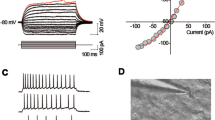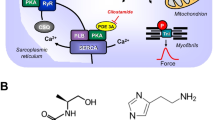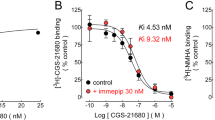Abstract
The effect of histamine and related drugs on the tritium overflow evoked electrically (0.3 Hz) or by introduction of Ca2+ ions into Ca2+-free K+-rich (25 mmol/l) medium containing tetrodotoxin was studied in superfused guinea-pig brain cortex, cerebellum, hippocampus or hypothalamus slices and in mouse brain cortex slices preincubated with 3H-noradrenaline. The electrically evoked tritium overflow in guinea-pig cortex slices was inhibited by histamine; the H3 receptor antagonist clobenpropit reversed the effect of histamine to a slight facilitation. The facilitatory effect of histamine (obtained in the presence of clobenpropit) was not affected by the H1 receptor antagonist mepyramine but abolished by the H2 receptor antagonist ranitidine. In the absence of clobenpropit, ranitidine augmented the inhibitory effect of histamine. In slices superfused in the presence of ranitidine, the evoked overflow was inhibited by histamine and, more potently, by the H3 receptor agonist R-α-methylhistamine in a concentration-dependent manner (maximum inhibitory effect obtained for both agonists 30–35%). The concentration-response curve of histamine was shifted to the right by the H3 receptor antagonist thioperamide. R-α-Methylhistamine inhibited the electrically evoked tritium overflow also in guinea-pig cerebellar, hippocampal and hypothalamic slices. In cortex slices superfused in the presence of clobenpropit, the H2 receptor agonists impromidine and, less potently, R-sopromidine facilitated the evoked overflow in a concentration-dependent manner. S-Sopromidine only tended to increase the evoked overflow. The effect of impromidine was counteracted by the H2 receptor antagonists ranitidine and cimetidine. The extent of the maximum facilitatory effect of impromidine (by 15–20%) was about the same when (i) the Ca2+ concentration in the medium was reduced from 1.3 to 0.98 mmol/l, (ii) the time of exposure to impromidine was reduced from 28 to 8 min or (iii) cerebellar, hippocampal or hypothalamic slices were used instead of cortical slices. The Ca2+-induced tritium overflow in guinea-pig cortex slices was inhibited by histamine (in the presence of ranitidine); this effect was abolished by clobenpropit. In slices superfused in the presence of clobenpropit, impromidine failed to facilitate the Ca2+-evoked tritium overflow. The electrically evoked tritium overflow in mouse brain cortex slices was inhibited by histamine by about 60% (both in the absence or presence of ranitidine). The inhibitory effect of histamine was abolished (but not reversed) by clobenpropit. In conclusion, noradrenaline release in the guinea-pig brain cortex is inhibited via presynaptic H3 receptors and facilitated via H2 receptors not located presynaptically. In the mouse brain cortex, only inhibitory H3 receptors occur. The extent of the H3 receptor-mediated effect is more marked in the mouse than in the guinea-pig brain cortex.
Similar content being viewed by others
Author information
Authors and Affiliations
Additional information
Received: 25 September 1997 / Accepted: 17 November 1997
Rights and permissions
About this article
Cite this article
Timm, J., Marr, I., Werthwein, S. et al. H2 receptor-mediated facilitation and H3 receptor-mediated inhibition of noradrenaline release in the guinea-pig brain. Naunyn-Schmiedeberg's Arch Pharmacol 357, 232–239 (1998). https://doi.org/10.1007/PL00005162
Issue Date:
DOI: https://doi.org/10.1007/PL00005162




